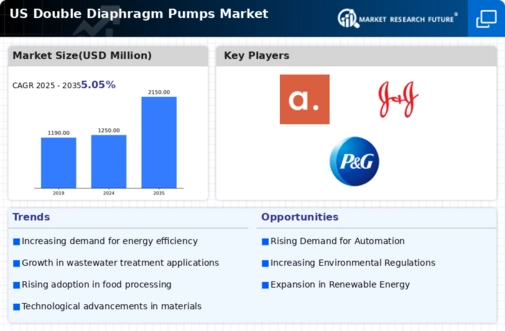Growth in Food and Beverage Industry
The double diaphragm-pumps market is benefiting from the expansion of the food and beverage industry, which demands high standards of hygiene and efficiency in fluid handling. As consumer preferences shift towards processed and packaged foods, manufacturers are increasingly adopting advanced pumping technologies to meet production demands. The food and beverage sector is projected to reach a market value of over $1 trillion by 2026, creating substantial opportunities for double diaphragm pumps. These pumps are favored for their ability to maintain product integrity while ensuring compliance with stringent health regulations. This trend suggests that the double diaphragm-pumps market will continue to see robust growth as food manufacturers seek reliable and hygienic pumping solutions.
Rising Demand in Chemical Processing
The double diaphragm-pumps market is experiencing a notable increase in demand within the chemical processing sector. This growth is primarily driven by the need for efficient and reliable fluid transfer solutions in various applications, including the handling of corrosive and viscous materials. The market for chemical processing equipment is projected to reach approximately $30 billion by 2026, indicating a robust growth trajectory. As industries seek to enhance operational efficiency and reduce downtime, double diaphragm pumps are favored for their ability to handle a wide range of fluids without compromising performance. This trend suggests that the double diaphragm-pumps market will continue to thrive as chemical manufacturers prioritize equipment that ensures safety and reliability in their operations.
Increased Focus on Industrial Automation
The market is poised for growth due to the increasing focus on industrial automation across various sectors. As manufacturers strive to enhance productivity and reduce labor costs, the integration of automated pumping systems is becoming more prevalent. The industrial automation market is expected to exceed $300 billion by 2025, indicating a strong trend towards automation in manufacturing processes. Double diaphragm pumps, known for their reliability and ease of integration with automated systems, are likely to see increased adoption. This trend suggests that the double diaphragm-pumps market will benefit from the broader shift towards automation, as industries seek to optimize their operations and improve efficiency.
Emerging Applications in Renewable Energy
The double diaphragm-pumps market is witnessing emerging applications in the renewable energy sector, particularly in biofuel production and solar energy systems. As the demand for clean energy solutions grows, industries are exploring innovative pumping technologies to support these initiatives. The renewable energy market is projected to grow at a CAGR of over 8% through 2030, creating new opportunities for double diaphragm pumps. These pumps are well-suited for handling various fluids involved in energy production processes, including viscous biofuels and cooling fluids in solar applications. This trend indicates that the double diaphragm-pumps market may experience significant growth as the renewable energy sector expands and seeks efficient fluid handling solutions.
Expansion in Water and Wastewater Management
The double diaphragm-pumps market is significantly influenced by the expansion of water and wastewater management initiatives across the United States. With increasing regulatory pressures and a growing emphasis on sustainable water practices, municipalities are investing in advanced pumping solutions. The market for water and wastewater treatment is expected to grow at a CAGR of around 6% through 2027, highlighting the need for efficient pumping systems. Double diaphragm pumps are particularly well-suited for these applications due to their ability to handle solids and slurries effectively. This trend indicates a strong potential for growth in the double diaphragm-pumps market as public and private sectors prioritize infrastructure improvements and environmental compliance.














Leave a Comment